Effect of TiN Coating on the Structure, Mechanical Properties and Fracture of the Mg-Ca-Zn Alloy
Abstract
:1. Introduction
2. Materials and Methods
3. Results and Discussion
3.1. Microstructure of the Initial Mg-Ca-Zn Alloy
3.2. Microstructure and XRD Analysis of the Mg-Ca-Zn Alloy with a 0.5 µm Thick TiN Coating
3.3. Mechanical Properties and Fracture of Mg-Ca-Zn Alloys with TiN Coatings of Different Thickness
4. Conclusions
Author Contributions
Funding
Acknowledgments
Conflicts of Interest
References
- Wu, R.Z.; Yan, Y.D.; Wang, G.X.; Murr, L.E.; Han, W.; Zhang, Z.W.; Zhang, M.L. Recent progress in magnesium–lithium alloys. Int. Mater. Rev. 2015, 60, 65–100. [Google Scholar] [CrossRef]
- Dobrzański, L.A.; Dobrzańska-Danikiewicz, A.D.; Dobrzański, L.B.; Dobrzańska, J. The Importance of Synthesis and Characterization of Biomedical Materials for the Current State of Medicine and Dentistry. Processes 2021, 9, 978. [Google Scholar] [CrossRef]
- Riaz, U.; Shabib, I.; Haider, W. The current trends of Mg alloys in biomedical applications—A review. J. Biomed. Mater. Res. Part B Appl. Biomater. 2019, 107, 1970–1996. [Google Scholar] [CrossRef] [PubMed]
- Huang, J.; Li, X.; Guo, Z.X. Biomechanical and biochemical compatibility in innovative biomaterials. In Biocompatibility and Performance of Medical Devices; Woodhead Publishing: Boston, UK, 2020; pp. 23–46. [Google Scholar] [CrossRef]
- Li, G.; Yang, H.; Zheng, Y.; Chen, X.-H.; Yang, J.-A.; Zhu, D.; Ruan, L.; Takashima, K. Challenges in the use of zinc and its alloys as biodegradable metals: Perspective from biomechanical compatibility. Acta Biomater. 2019, 97, 23–45. [Google Scholar] [CrossRef] [PubMed]
- Wang, J.; Pang, X.; Jahed, H. Surface protection of Mg alloys in automotive applications: A review. AIMS Mater. Sci. 2019, 6, 567–600. [Google Scholar] [CrossRef]
- Li, W.; Qiao, W.; Liu, X.; Bian, D.; Shen, D.; Zheng, Y.; Wu, J.; Kwan, K.Y.H.; Wong, T.M.; Cheung, K.M.C.; et al. Biomimicking Bone–Implant Interface Facilitates the Bioadaption of a New Degradable Magnesium Alloy to the Bone Tissue Microenvironment. Adv. Sci. 2021, 8, 2102035. [Google Scholar] [CrossRef]
- Du, H.; Wei, Z.; Liu, X.; Zhang, E. Effects of Zn on the microstructure, mechanical property and bio-corrosion property of Mg–3Ca alloys for biomedical application. Mater. Chem. Phys. 2011, 125, 568–575. [Google Scholar] [CrossRef]
- Staiger, M.P.; Pietak, A.M.; Huadmai, J.; Dias, G. Magnesium and its alloys as orthopedic biomaterials: A review. Biomaterials 2006, 27, 1728–1734. [Google Scholar] [CrossRef]
- Tsakiris, V.; Tardei, C.; Clicinschi, F.M. Biodegradable Mg alloys for orthopedic implants—A review. J. Magnes. Alloy. 2021, 9, 1884–1905. [Google Scholar] [CrossRef]
- Prakasam, M.; Locs, J.; Salma-Ancane, K.; Loca, D.; Largeteau, A.; Berzina-Cimdina, L. Biodegradable Materials and Metallic Implants—A Review. J. Funct. Biomater. 2017, 8, 44. [Google Scholar] [CrossRef] [Green Version]
- Wang, J.-L.; Xu, J.-K.; Hopkins, C.; Chow, D.H.-K.; Qin, L. Biodegradable Magnesium-Based Implants in Orthopedics—A General Review and Perspectives. Adv. Sci. 2020, 7, 1902443. [Google Scholar] [CrossRef] [PubMed] [Green Version]
- Atrens, A.; Shi, Z.; Mehreen, S.U.; Johnston, S.; Song, G.-L.; Chen, X.; Pan, F. Review of Mg alloy corrosion rates. J. Magnes. Alloy. 2020, 8, 989–998. [Google Scholar] [CrossRef]
- Castellani, C.; Lindtner, R.A.; Hausbrandt, P.; Tschegg, E.; Stanzl-tschegg, S.E.; Zanoni, G.; Beck, S.; Weinberg, A.-M. Bone–implant interface strength and osseointegration: Biodegradable magnesium alloy versus standard titanium control. Acta Biomater. 2011, 7, 432–440. [Google Scholar] [CrossRef] [PubMed]
- Ding, C.; Tai, Y.; Wang, D.; Tan, L.; Fu, J. Superhydrophobic composite coating with active corrosion resistance for AZ31B magnesium alloy protection. Chem. Eng. J. 2019, 357, 518–532. [Google Scholar] [CrossRef]
- Liu, J.; Song, Y.; Chen, J.; Chen, P.; Shan, D.; Han, E.H. The Special Role of Anodic Second Phases in the Micro-galvanic Corrosion of EW75 Mg Alloy. Electrochim. Acta 2016, 189, 190–195. [Google Scholar] [CrossRef]
- Jang, H.S.; Seol, D.; Lee, B.J. A comparative study on grain boundary segregation and solute clustering in Mg-Al-Zn and Mg-Zn-Ca alloys. J. Alloys Compd. 2022, 894, 162539. [Google Scholar] [CrossRef]
- Wang, X.J.; Xu, D.K.; Wu, R.Z.; Chen, X.B.; Peng, Q.M.; Jin, L.; Xin, Y.C.; Zhang, Z.Q.; Liu, Y.; Chen, X.H.; et al. What is going on in magnesium alloys? J. Mater. Sci. Technol. 2017, 34, 245–247. [Google Scholar] [CrossRef]
- Ghali, E.; Dietzel, W.; Kainer, K.U. General and localized corrosion of magnesium alloys: A critical review. J. Mater. Eng. Perform. 2004, 13, 7–23. [Google Scholar] [CrossRef]
- Pan, H.; Yang, C.; Yang, Y.; Dai, Y.; Zhou, D.; Chai, L.; Huang, Q.; Yang, Q.; Liu, S.; Ren, Y.; et al. Ultra-fine grain size and exceptionally high strength in dilute Mg–Ca alloys achieved by conventional one-step extrusion. Mater. Lett. 2019, 237, 65–68. [Google Scholar] [CrossRef]
- Sahu, M.R.; Kumar, T.S.S.; Chakkingal, U. A review on recent advancements in biodegradable Mg-Ca alloys. J. Magnes. Alloy. 2022, 10, 2094–2117. [Google Scholar] [CrossRef]
- Istrate, B.; Munteanu, C.; Antoniac, I.-V.; Lupescu, Ș.-C. Current Research Studies of Mg–Ca–Zn Biodegradable Alloys Used as Orthopedic Implants—Review. Crystals 2022, 12, 1468. [Google Scholar] [CrossRef]
- Huang, S.J.; Ali, A.N. Experimental investigations of effects of SiC contents and severe plastic deformation on the microstructure and mechanical properties of SiCp/AZ61 magnesium metal matrix composites. J. Mater. Process. Technol. 2019, 272, 28–39. [Google Scholar] [CrossRef]
- Tian, B.; Yue, W.; Fu, Z.; Gu, Y.; Wang, C.; Liu, J. Microstructure and tribological properties of W-implanted PVD TiN coatings on 316L stainless steel. Vacuum 2014, 99, 68–75. [Google Scholar] [CrossRef]
- Łępicka, M.; Grądzka-Dahlke, M.; Pieniak, D.; Pasierbiewicz, K.; Kryńska, K.; Niewczas, A. Tribological performance of titanium nitride coatings: A comparative study on TiN-coated stainless steel and titanium alloy. Wear 2019, 422, 68–80. [Google Scholar] [CrossRef]
- Ou, Y.X.; Lin, J.; Tong, S.; Sproul, W.D.; Lei, M.K. Structure, adhesion and corrosion behavior of CrN/TiN superlattice coatings deposited by the combined deep oscillation magnetron sputtering and pulsed dc magnetron sputtering. Surf. Coat. Technol. 2016, 293, 21–27. [Google Scholar] [CrossRef]
- Baigonakova, G.; Marchenko, E.; Zhukov, I.; Vorozhtsov, A. Structure, cytocompatibility and biodegradation of nanocrystalline coated Mg–Ca–Zn alloys. Vacuum 2023, 207, 111630. [Google Scholar] [CrossRef]
- Zhang, Z.; Zhao, Z.; Bai, P.; Li, X.; Liu, B.; Tan, J.; Wu, X. In-situ monitoring of pitting corrosion of AZ31 magnesium alloy by combining electrochemical noise and acoustic emission techniques. J. Alloys Compd. 2021, 878, 160334. [Google Scholar] [CrossRef]
- Habibnejad-Korayem, M.; Mahmudi, R.; Ghasemi, H.M.; Poole, W.J. Tribological behavior of pure Mg and AZ31 magnesium alloy strengthened by Al2O3 nano-particles. Wear 2010, 268, 405–412. [Google Scholar] [CrossRef]
- Lin, C.J.; Chen, K.C.; He, J.L. The cavitation erosion behavior of electroless Ni-P-SiC composite coating. Wear 2006, 261, 1390–1396. [Google Scholar] [CrossRef]
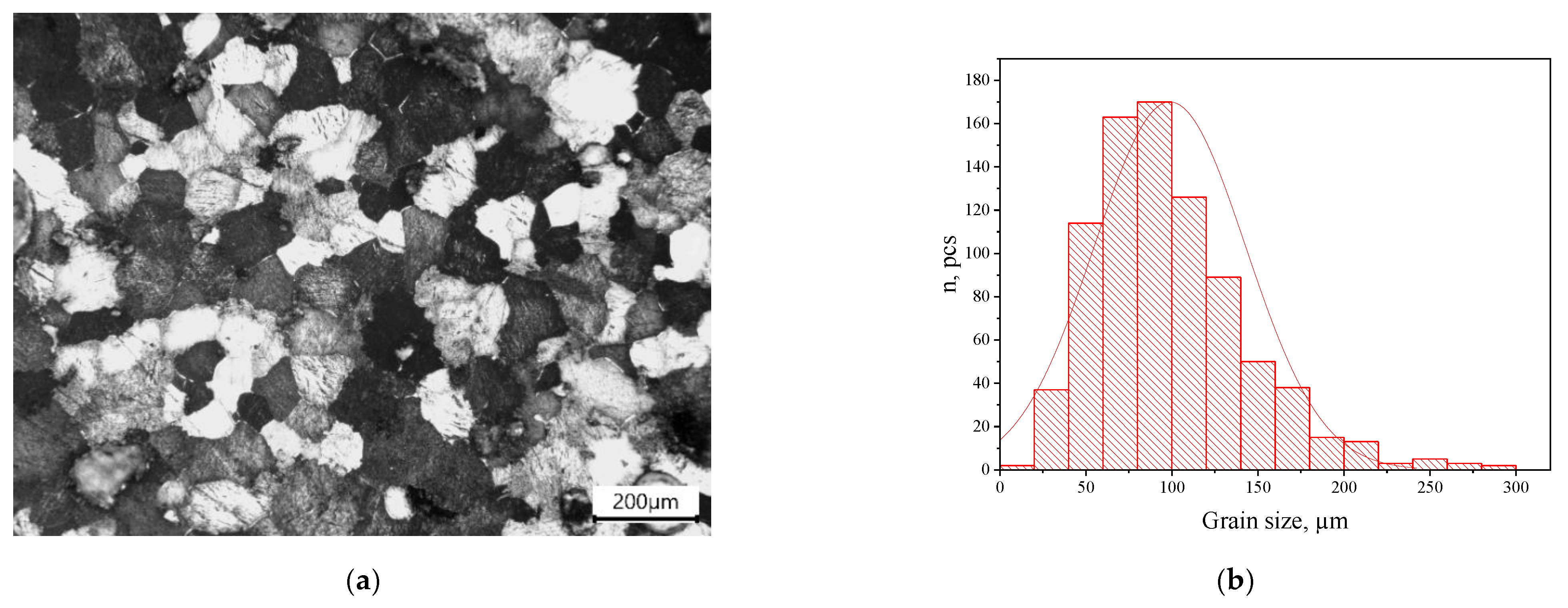

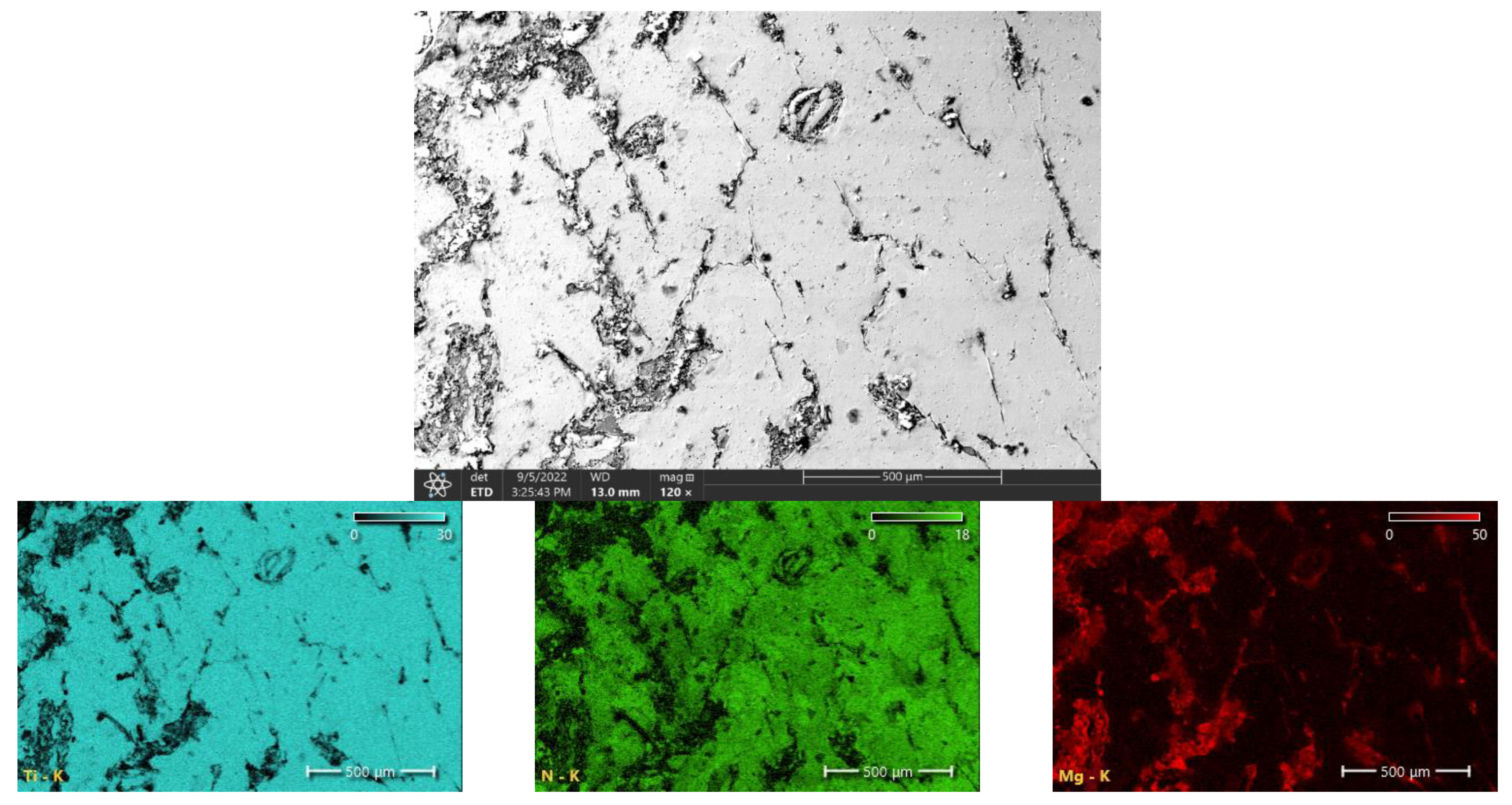
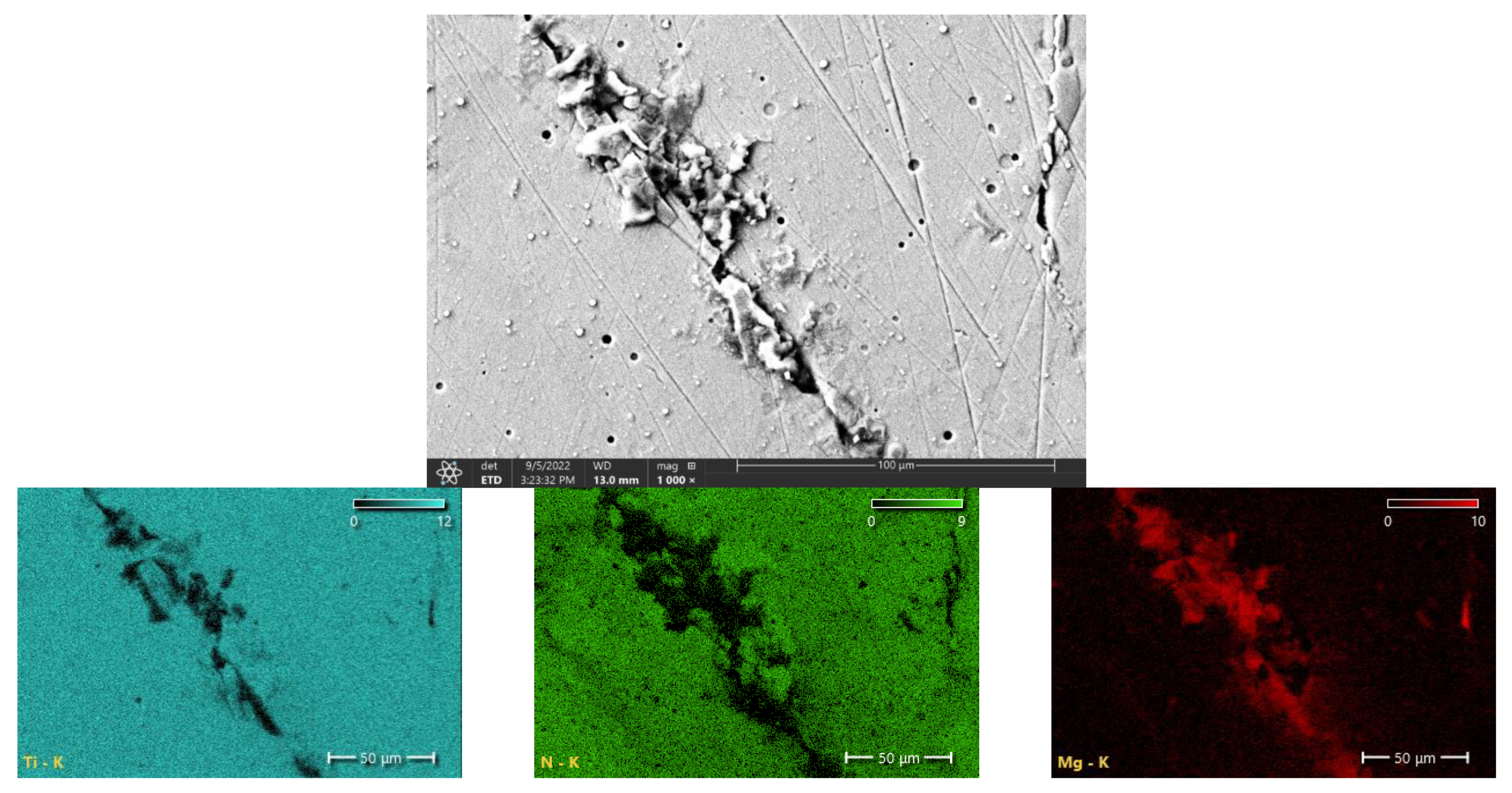
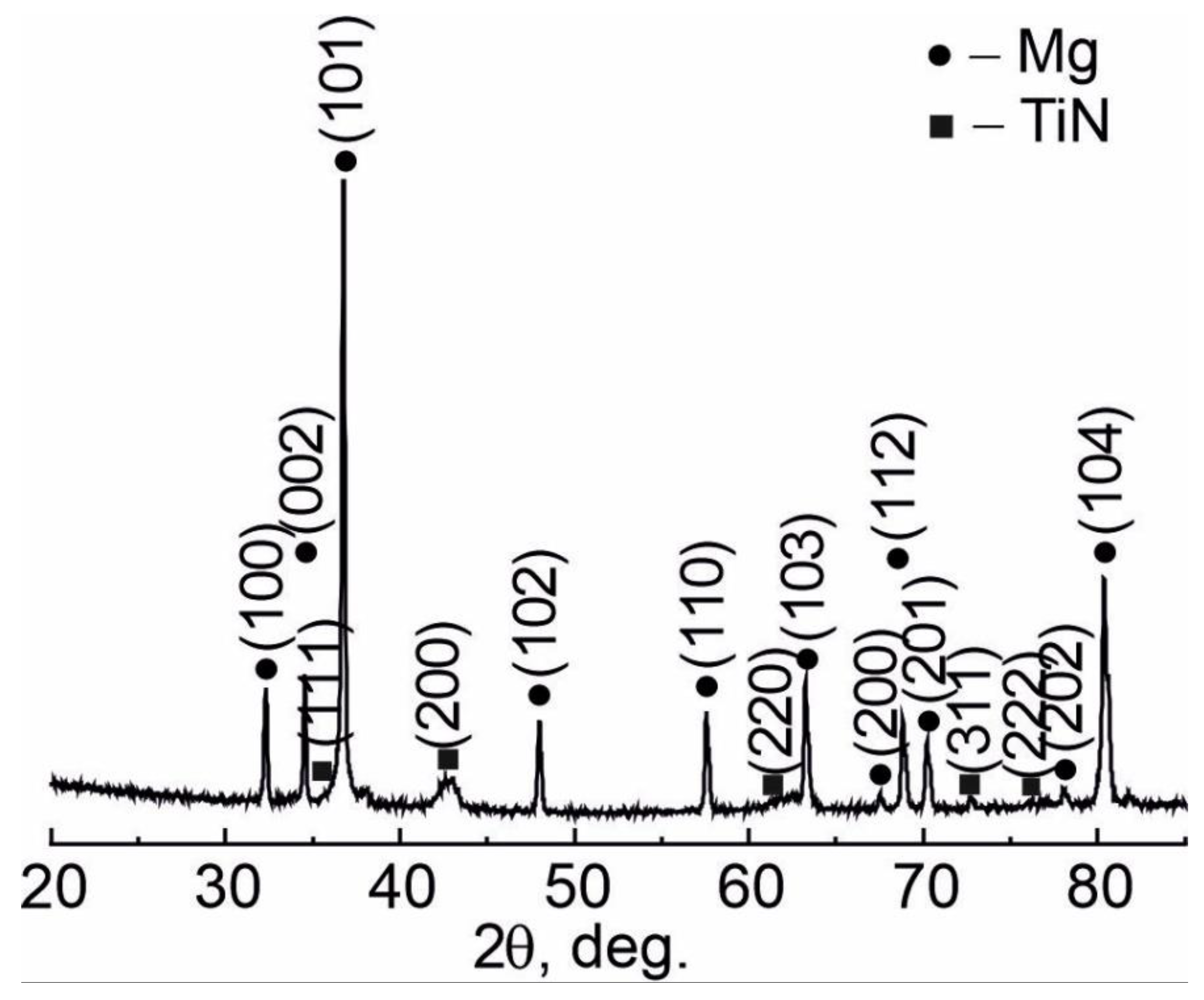

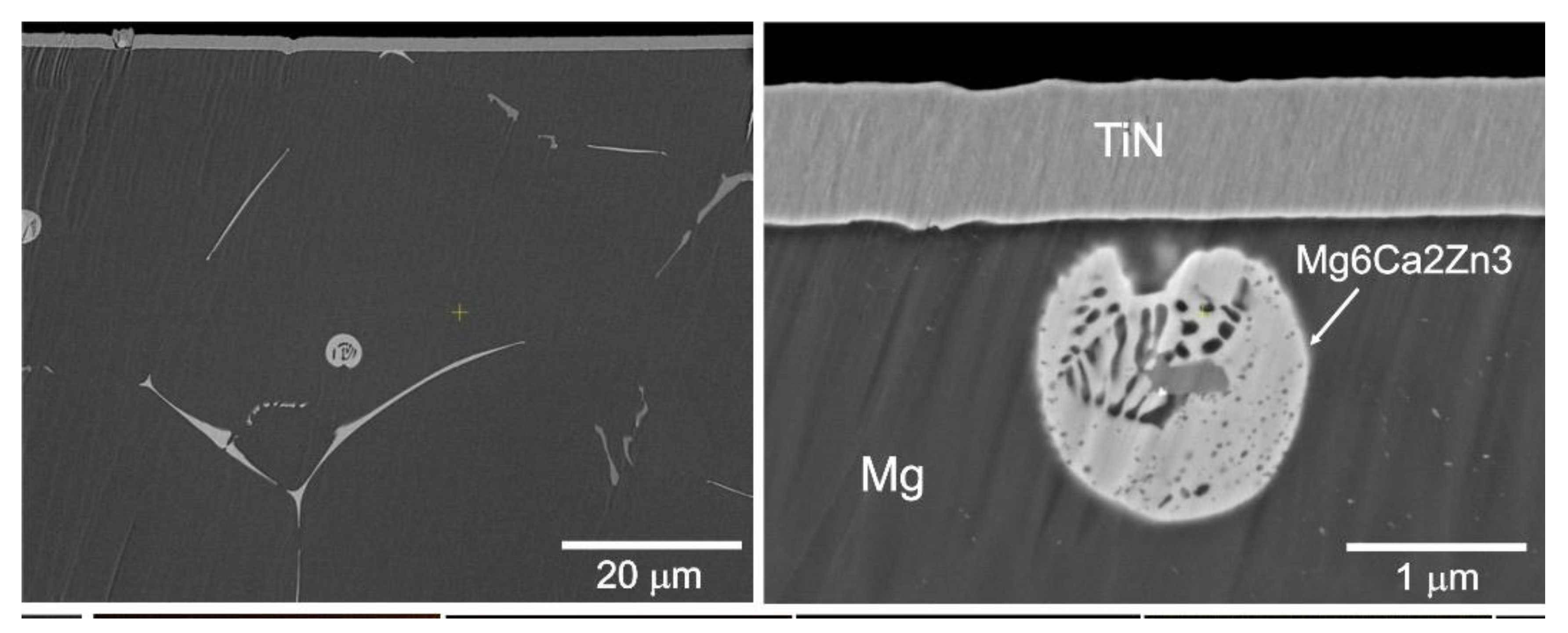
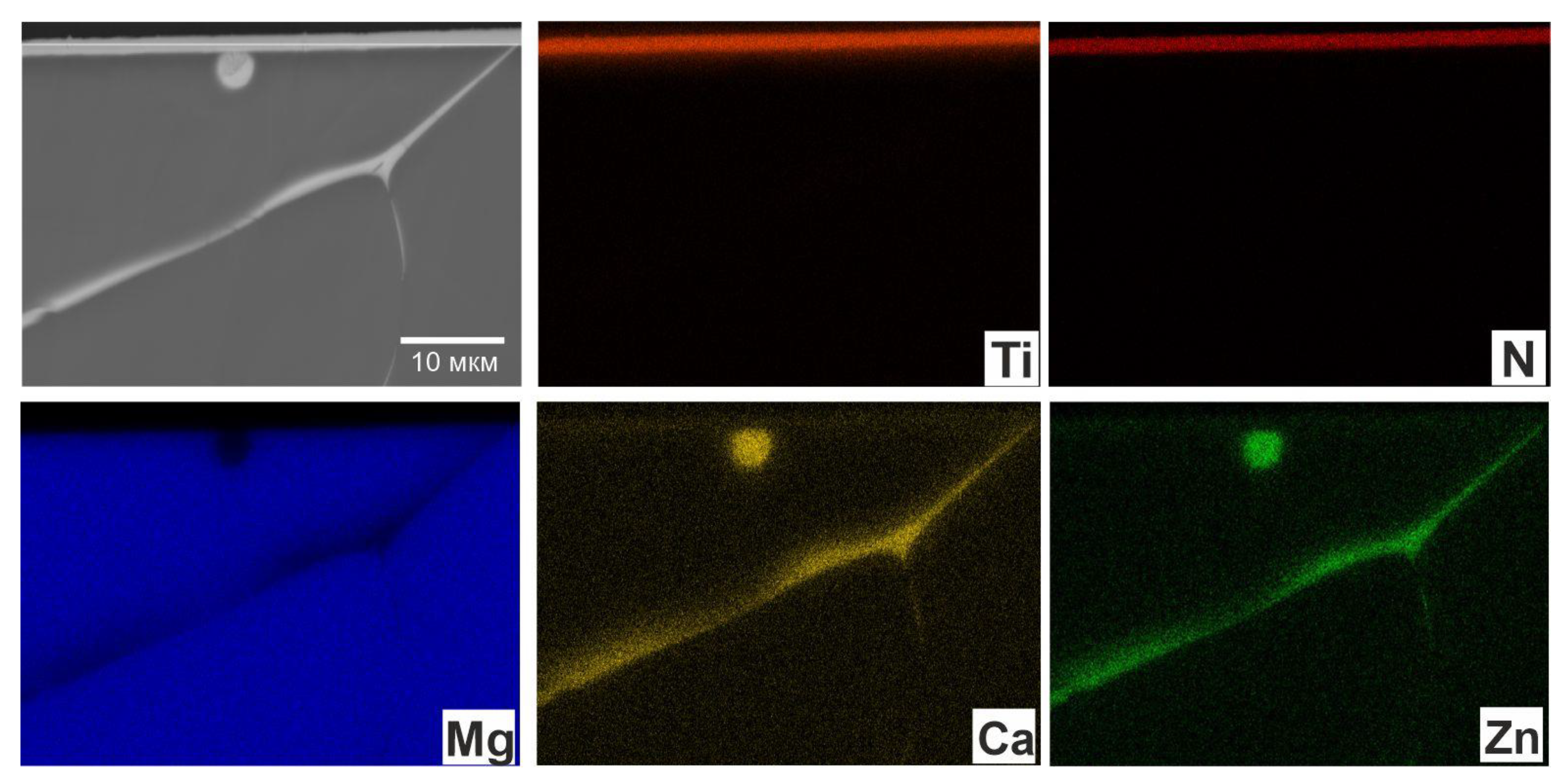
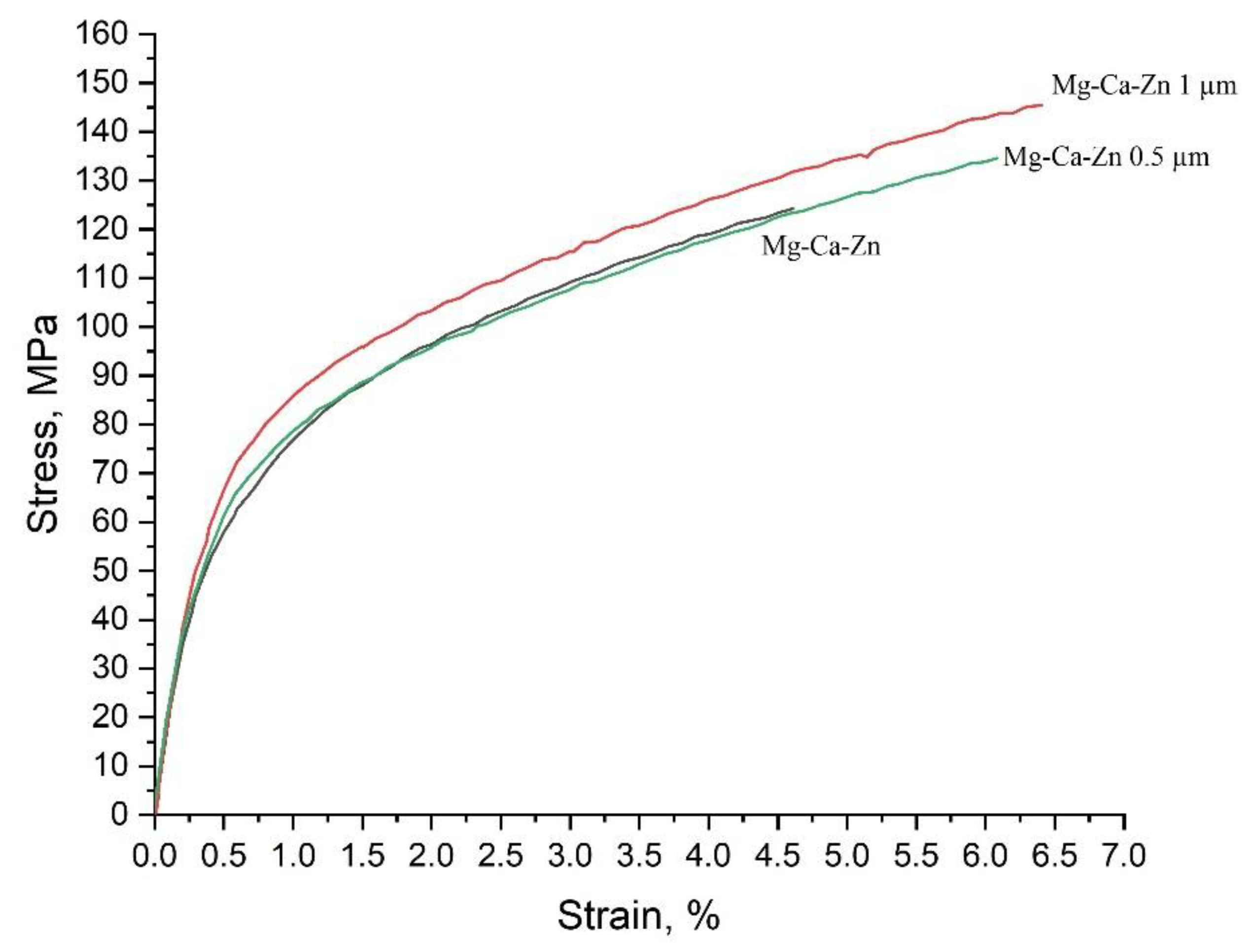
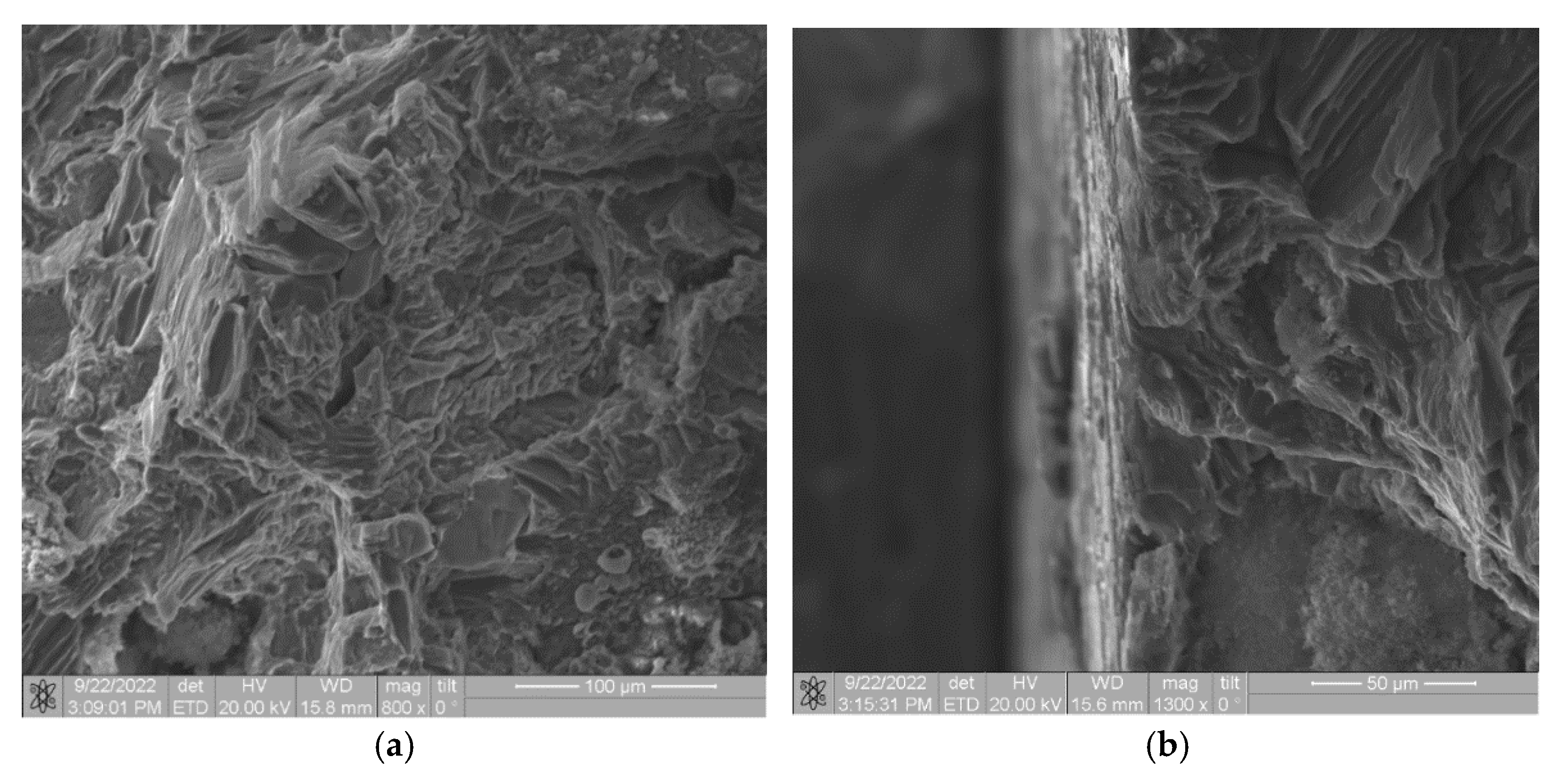

| Phase | Volume Fraction, vol. % | Lattice Parameters, Å and Unit Cell Volume, Å3 | CSR Dimensions, nm | Microdistortions, Δd/d |
|---|---|---|---|---|
| Mg | 91 | a = 3.1775 c = 5.2826 V = 46.1902 c/a = 1.6625 | 59 | 1.7 × 10−3 |
| Mg6Ca2Zn3 | 4 | a = 10.0236 c = 96067 V = 835.39 | 37 | 1.4 × 10−3 |
| TiN | 5 | a = 4.3199 V = 80.6160 | 31 | 2.6 × 10−3 |
| Phase | Volume Fraction, vol. % | Lattice Parameters, Å and Unit Cell Volume, Å3 | CSR Dimensions, nm | Microdistortions, Δd/d |
|---|---|---|---|---|
| Mg | 78 | a = 3.2047 c = 5.2052 V = 46.2959 c/a = 1.6242 | 58 | 1.7 × 10−3 |
| TiN | 19 | a = 4.2896 V = 78.9315 | 21 | 2.5 × 10−3 |
| Alloy | Microhardness, HV | σ0.2, MPa | σB, MPa | δ, % |
|---|---|---|---|---|
| Mg-Ca-Zn | 56 ± 4 | 58 ± 4 | 121 ± 8 | 4.6 ± 0.3 |
| Mg-Ca-Zn 0.5 | 131 ± 36 | 67 ± 8 | 138 ± 7 | 6.1 ± 0.5 |
| Mg-Ca-Zn 1 | 132 ± 16 | 74 ± 2 | 152 ± 5 | 6.4 ± 0.1 |
Publisher’s Note: MDPI stays neutral with regard to jurisdictional claims in published maps and institutional affiliations. |
© 2022 by the authors. Licensee MDPI, Basel, Switzerland. This article is an open access article distributed under the terms and conditions of the Creative Commons Attribution (CC BY) license (https://creativecommons.org/licenses/by/4.0/).
Share and Cite
Khrustalyov, A.; Monogenov, A.; Baigonakova, G.; Akhmadieva, A.; Marchenko, E.; Vorozhtsov, A. Effect of TiN Coating on the Structure, Mechanical Properties and Fracture of the Mg-Ca-Zn Alloy. Metals 2022, 12, 2140. https://doi.org/10.3390/met12122140
Khrustalyov A, Monogenov A, Baigonakova G, Akhmadieva A, Marchenko E, Vorozhtsov A. Effect of TiN Coating on the Structure, Mechanical Properties and Fracture of the Mg-Ca-Zn Alloy. Metals. 2022; 12(12):2140. https://doi.org/10.3390/met12122140
Chicago/Turabian StyleKhrustalyov, Anton, Alexander Monogenov, Gulsharat Baigonakova, Anastasia Akhmadieva, Ekaterina Marchenko, and Alexander Vorozhtsov. 2022. "Effect of TiN Coating on the Structure, Mechanical Properties and Fracture of the Mg-Ca-Zn Alloy" Metals 12, no. 12: 2140. https://doi.org/10.3390/met12122140
APA StyleKhrustalyov, A., Monogenov, A., Baigonakova, G., Akhmadieva, A., Marchenko, E., & Vorozhtsov, A. (2022). Effect of TiN Coating on the Structure, Mechanical Properties and Fracture of the Mg-Ca-Zn Alloy. Metals, 12(12), 2140. https://doi.org/10.3390/met12122140







